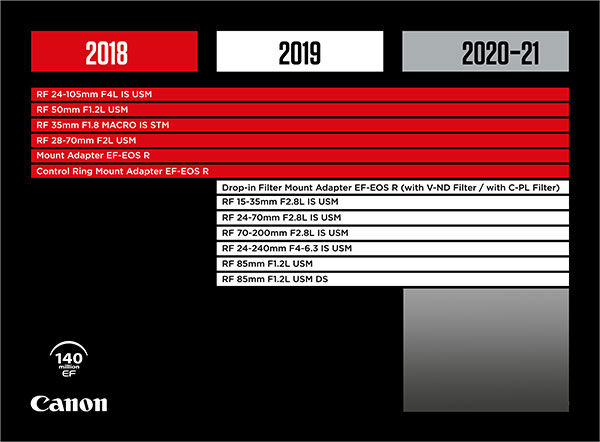The is my experience shooting the Canon R for 4 months. It is not an in-depth review checking every feature. I shot very little video with it so video won't be in this discussion.
I love Canon’s APS-C M cameras and Full Frame DSLRs and have owned and used almost all current models including M3, M5, M6, M50, T3i, 70D, 7D Mark II, 5D Mark III, 5D Mark IV, 5Dsr, 6D, 6D Mark II, and the EOS R. A Full Frame Canon mirrorless camera would be a natural progression and possibly my ideal camera system. I also like trying out the latest gear. I bought the EOS R November 2018 and sold it March 2019.
PROS:
NEUTRAL:
1 of 3
I love Canon’s APS-C M cameras and Full Frame DSLRs and have owned and used almost all current models including M3, M5, M6, M50, T3i, 70D, 7D Mark II, 5D Mark III, 5D Mark IV, 5Dsr, 6D, 6D Mark II, and the EOS R. A Full Frame Canon mirrorless camera would be a natural progression and possibly my ideal camera system. I also like trying out the latest gear. I bought the EOS R November 2018 and sold it March 2019.
PROS:
- Potential for fast lenses. A definite plus for people who want fast lenses. For me, since I usually shoot at f/8-f/22 and with a tripod, I’d be happy with an RF 17-40 f/4, 24-70 f/4, 70-200 f/4, and a 100 macro.
- Lighter and smaller than a DSLR, but not by that much. The bodies might be smaller and lighter but the lenses aren’t by that much.
- The lens control ring is pretty cool, though RF lenses or the right adaptor are required.
- Configurability. I’ve never customized my DSLRs, I guess I haven’t had to, but the R lacked a depth of field button so I was forced to customize a button to get the depth of field function. Now that I’ve done it, customization is pretty cool.
- As with all mirrorless cameras, locking up the mirror is no longer required when shooting macro or landscape shots.
- Same battery as the DSLRs.
- Realtime exposure preview in LCD
- Handled 0F-20F temps with ease.
NEUTRAL:
- Smaller – This is a judgment call on whether this is a pro or con. I notice it when gripping the camera and shooting freehand. The grip isn’t as comfortable to hold as a 5D Mark IV since it’s smaller. This is noticeable when there is a telephoto attached and are shooting free hand.
- The common complaints from dpreview and youtube reviewers and commenters: single card slot, cropped 4k video with no DPAF, no IBIS. None of these impact me and my photography. I don’t shoot much video. When I do it’s with my M50 or iPhone, and 1080/24p is my format of choice. Most of my photography is on a tripod so IBIS makes little difference to me. Two card slots? I’ve never had an SD card fail on me. Honestly, the commenters on dpreview and to some extent the reviewers just nitpick and magnify the importance of missing features that are really insignificant to most photographers.
- HDR is not great. Used it a few times. I need to test this feature more, but am not impressed so far. I haven’t used it that much in my DSLRs so it’s tough to make an accurate assessment without more testing.
- Top deck LCD – This is a vestige leftover from the film SLR days when there was no LCD in back. This is an unnecessary feature that just consumes space and battery life. With a tiltable and flippable LCD display, why is an additional top deck LCD necessary or even desirable? The back LCD has all the info the top deck has and with the tiltable screen there is no reason to have and LCD on top anymore.
- One thing I hated but found a way to turn off was the EVF sensor. When you put your eye or anything up to the EVF there is a sensor that turns off the LCD which is what I use to compose now since I'm so used to shooting pix with a phone. I accidentally trigger the EVF sensor on almost every shoot. It is configurable! 4th yellow Set-up Menu screen -> Display Settings -> Display Control -> Manual Display Control. Then select Manual display either Viewfinder or Screen. It's Viewfinder by default.
1 of 3
Last edited:

